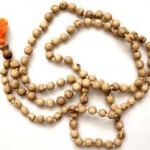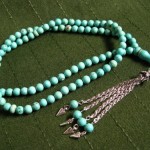The Prayer Beads Phenomenon
Oct 08, 2012 by Nick Rabiipour
Did you know that, according to prayerbeadsworld.com, prayer beads are used by Muslims, Jews, Christians, Buddhists, Sikhs, and Hindu Brahmanists? Why do these very different faiths use prayer beads? What is it about prayer beads that attracts religion and spirituality? This question is very interesting to me, and in order to answer it I had to do some research. Here is a brief summary of how some different faiths use prayer beads in their religion.
 Hinduism – Japa Mala Beads
Hinduism – Japa Mala Beads
Hinduism is thought to be the first religion to use prayer beads. They use their prayer beads to keep track of the amount of times they repeat a mantra or name of a deity. A mantra is a word or series of words chanted aloud or silently in order to invoke spiritual qualities in the person chanting. Praying with Japa Mala beads seems to be meditation for the sake of self-betterment.
 Islam – Misbaha or Tesbih
Islam – Misbaha or Tesbih
Islam’s Tesbih is essentially a meditation on God or Allah. The Tesbih is made of 99 beads, corresponding to the 99 names of Allah, broken into 3 sections. In the first section you repeat the English equivalent “Praise be to God,” then in the second section you repeat “Glory to God,” and in the last section “God is the greatest.” Sometimes the Tesbih only has 33 beads and one cycles through the beads three times. This prayer seems to also be said as a meditation but it was given by Mohammed to the poor in order that they might “catch up with those who have surpassed you (those surpassing are the wealthy)” (Book #12 Hadith #804). It seems that this prayer, like the Japa Mala, has been used for self-improvement and betterment.
 Christianity – The Rosary, Chaplet, Chotki, Prayer Ropes
Christianity – The Rosary, Chaplet, Chotki, Prayer Ropes
In Christianity there many different types of prayer beads. The most popular is by far the rosary in which one meditates on the mysteries of Christ as well as petitions the Mother of God. Chaplets are similar to the rosary but with only ten prayer beads and are often associated with a particular Christian devotion. The chotki are prayer beads used in the Eastern Orthodox Church as a means of praying the Jesus Prayer (very similar to the Tesbih). Prayer Ropes are also used by the Orthodox as a means of counting prayers. Christian Prayer Beads are a sort of hybrid between the chotki and the rosary. Christian prayer beads are also used by Christians outside of the Catholic and Orthodox Churches as both a meditation and a petition of God.
It seems that these three major faiths all use prayer beads as an aid for repetitive prayer in which the goal is at least mediation. It is easy to see that when performing repetitive prayer, it helps to have something to keep track of the number of prayers prayed. Hence it makes sense that someone would use something like beads in repetitive prayer because they are small, inexpensive, and easy to make. And repetitive prayer by nature seems to aid meditation, and meditation is important to any religion. Prayer beads have been powerful in my life and they have helped me in meditating on the mysterious life of Christ. Do you pray with a rosary, a chaplet, or another kind of prayer bead? Have they helped you meditate in repetitive prayer?




